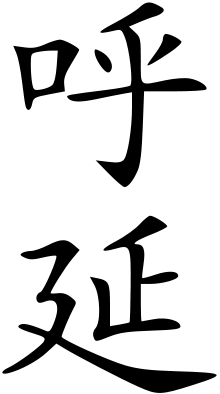Huyan
| Huyan | |
|---|---|
 Huyan in regular script | |
| Pronunciation | Hūyǎn (Pinyin) |
| Language(s) | Chinese |
| Origin | |
| Language(s) | Xiongnu language |
| Derivation | name of the earliest matrilineal ancestor of the Huyan clan |
The Huyan (Chinese: 呼延; Wade–Giles: Hu-yen) was a noble house that led the last remnants of the Northern Xiongnu to Dzungaria during the second century after the Battle of the Altai Mountains. The House of Huyan is an earlier maternal lineage name subsequently replaced by Xubu, much as the Ashina and Yujiulu (郁久閭).[1][2][3] Mongolian Khiyad tribe's name is probably derived from Huyan.[4]
By the 3rd century BCE, the upper stratum of the Xiongnu was made up of five aristocratic houses, Luandi (house of the Chanyu and the Tuqi King of the east and west), Huyan, Xubu, Qiulin and Lan. Both the Huyan and Xubu settled in the east, Qiulin and Lan in the west and Luandi at the center of Mongolia.[1][2][5]
Prominent people with family name Huyan
- Empress Huyan, wife of Han Zhao's founding emperor, Liu Yuan
- Empress Huyan, wife of Liu Yuan's son, Liu Cong, the fourth emperor of Han Zhao
- Empress Huyan, wife of Murong Chao, emperor of the Southern Yan
- Huyan Zan (呼延贊), general of the Song dynasty (d. 1000)
- Huyan Zhuo (呼延灼), fictitious descendant of Huyan Zan in Water Margin, one of the Four Great Classical Novels
Notes
- 1 2 Lin (1986), p. 33–45, 114-119
- 1 2 Wang (2004), p. 132–147,
- ↑ Bichurin N.Ya., "Collection of information on peoples in Central Asia in ancient times", vol. 1, Sankt Petersburg, 1851, p. 15 ( note 1: Huyan and Xubu always were in marital relationship with the Chanyu. Xubu had a post of the State Judge. The custom of taking for the Khan maidens only from the same houses also survived in the Chingis-khan's house.)
- ↑ History of Mongolia, Ulaanbaatar, 2003
- ↑ Gumilev L.N., "Hunnu in China", Moscow, 'Science', 1974
References
- Lin, Gan (1986). A Comprehensive History of Xiongnu. Beijing: People's Press. CN / K289.
- Wang, Zhonghan (2004). Outlines of Ethnic Groups in China. Taiyuan: Shanxi Education Press. ISBN 7-5440-2660-4.
- Gumilev L.N., "Hunnu in China", Moscow, 'Science', 1974, ISBN 5-85990-092-9
This article is issued from
Wikipedia.
The text is licensed under Creative Commons - Attribution - Sharealike.
Additional terms may apply for the media files.